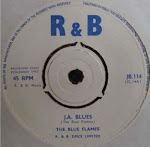This writer, a pioneering mod, recalls a world of clubs, cliques and fearless tailoring
IN THE FIFTIES, everybody grew up looking like their parents. It was just so grey. There was no music, no clothes and you didn’t have that many places to go. My sister Gloria, who was four years older than me, was a bit of a Beat, as they were called at the time, and she used to go to
This was round about 1959. Then she really got into R’n’B music, people like LaVern Baker, Joe Turner, Ray Charles, the Drifters. Her big favourites were the Shirelles and she actually got to run their fan club, which unlocked a whole lot of things because then she started taking me to the clubs where all this music was going on. I guess I was about 14 and we used to go along with her pal and her brother, Geoff Lewis. So my sister was the one who told me: “Get some pointed shoes,” and got my mother to take up all the turn-ups on my trousers and put buttons on my shirt collar.
I was now a Mod. I used to come up to London and buy clothes but an awful lot of stuff you got made or you made it yourself or you found things in bizarre places. We used to buy cricket whites, cheap cotton ones from C&A, and dye them ourselves — bright yellow, orange — because you couldn’t buy bright coloured clothes.
We would have them shortened by two inches so you could show off your socks. I remember buying a scarlet shirt and my dad saying to me, “Where are you going? Bullfighting?” He’d never seen a scarlet shirt before. My mother was brilliant because she was a dressmaker and she used to make stuff. At the time, we used to go to the Scene club in Ham Yard (
All they made were dancing shoes but they had these shoes with a Cuban heel and a seam down the middle, which was very unusual. I think they were flamenco shoes and somebody saw them and said: “Right, I’ll have those.” This was well before the Beatles.
We used to go to Heathrow airport on our scooters. There was a bowling alley there and the shoes were fantastic, three colours and with your size written on the back. So we would put on our sy shoes and walk out in a pair of these bowling shoes, cost you nothing. Then you would get a coffee late at night in the airport.
Mods were not that interested in groups. We were into records. Monday nights we used to go to the Lyceum in Streatham and the Orchid in Purley, sometimes both on the same night. Tuesday we stayed in. Wednesdays was the Wimbledon Palais, Thursdays it was the
You had to watch it a little bit if you went to clubs in different parts of town that were not your own. You tended not to chat birds up at those places although there weren’t that many good-looking Mod birds to go round.
It was a very male thing. It was also a tribal thing. There was a period when all the East London boys wore blue suits and all the
In my team there was Denzil (who appeared on the cover of the Sunday Times Magazine, August 2, 1964 – See “Changing Faces” elsewhere on the blog) and Pete Saunders who later became a DJ. The other one who was a pal was Mickey Finn, who got pally with the DJ Guy Stevens and later on teamed up with Marc Bolan in T. Rex.
There were a few fights but unlike what Stan Cohen, the sociologist, says about it all being speed orientated, it wasn’t. People only really took speed at the weekends and they did so to keep awake. Then they started thinking, “This pill isn’t bad,” and stepped up the dosage until they got right out of their boxes.
The end of it was
What broke your heart was that it all got so big, plus it didn’t help when the papers blew up the stories about the pills. The centre of gravity moved from
From July 28, 2003




4 comments:
Very cool. And articulate.
A fantastic insight to the early modernists...brilliant
Alfredo:
I'm trying to find info on Vittorio/Viktor, a 23-year-old Italian who used to go to Les Enfants Terrible in 1964. (He's a friend's dad; we're looking for him but don't have the last name - a mission of mercy!)
Would you email me?
Thank you,
Nicole Burton
njburton@hotmail.com
I think I knew Pete Saunders, mentioned in this article.
If I remember correctly he lived in Ewell (I know that Frederico Marcantonio did because I knew his siter)and if it's the same guy, he worked at George Newnes, publishers of woman's Own, Flair, Nova etc. at the same time I did. He was a clothes fanatic (and soul fan, like me)and went off to the USA, returning at the time that Donovan's first electric album came out
Post a Comment